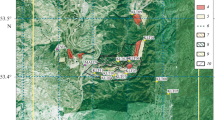Abstract
The Central Queensland University (CQU) Regional Seismic Network is made up of an array of six short-period seismometer and two strong motion accelerometer stations. The array has an aperture of about 50 km. CQU is able to resolve epicentral co-ordinates to about ±2 kilometres, with a sample rate of 100 per second, and an absolute time accuracy of 100 milliseconds. This resolution is achieved by using triaxial seismometers which allow better secondary phase identification of shear, converted and depth phases.
The network covers an area of above average seismic risk in continental Australia. The area has been affected in 1918 by one of the largest earthquakes ever recorded along the eastern seaboard of Australia. The network also monitors a large number of blasts carried out by the coal mines and hard rock, quarries in the region, and these are being used in a long-term study to determine the structure of the Crust and Upper Mantle in Central Queensland.
Techniques for monitoring rockbursts and longwall caving in mines are similar, to those used for monitoring local earthquakes. CQU has successfully used a single triaxial seismometer to record seismic events produced by the strata failure and roof falls of a longwall coal mine. The case history presented shows that the initial fall under massive roof conditions appears to be predicted by a simple trend plot of microseismic event magnitude and longwall production rate. Extension of this technique to a closely spaced array of both surface and in-seam triaxial seismometers is required for a more detailed appraisal to be undertaken. Adequate resolution of event location requires a higher, sample rate (up to 1000 Hz) and more accurate timing (about 1 millisecond) than for earthquake monitoring. An appropriate stratigraphic model is also required, as is the case for earthquake location.
Similar content being viewed by others
References
Ben Sliman, K., andRevalor, R.,Some results on the accuracy of the location of mining-induced seismic events: Experience of French coal mines. InInduced Seismicity (ed. Knoll, P.) (Balkema, Rotterdam 1992) pp. 3–20.
Bollinger, G. A.,Microearthquake activity associated with underground coal-mining in Buchanan County, Virginia, U.S.A. InSeismicity in Mines (ed. Gibowicz, S. J.) (Birkhäuser Verlag, Berlin 1989) p. 407.
Brune, J. N. (1970),Tectonic Stress and the Spectra of Seismic Shear Waves from Earthquakes, J. Geophys. Res.75, 4997–5009.
Bryan, W. H., andWhitehouse, F. W. (1938),The Gayndah Earthquake of 1935, Proceedings of the Royal Society of Queensland49, 106–119.
Cooper, W. V., McKavanagh, B. M., Boreham, B. W., McCue, K., Cuthbertson, R. J., andGibson, G. (1992),The Regional Seismographic Network and Seismicity of Central Queensland, BMR J. Australian Geology and Geophys.13, 107–111.
Cuthbertson, R. J. (1990),The Seismo-tectonics of Southeast Queensland, Bureau of Mineral Resources Bulletin, Australia,232, 67–81.
Cuthbertson, R. J. (1989),Geological Implications of Eastern Queensland Seismicity and Focal Mechanisms of Earthquakes in Southeast Queensland, Bureau of Mineral Resources Bulletin, Australia, Record 1989, 6.
Enever, J. R. (1990), “In situ stress measurements in the Bowen Basin and their implications for coal mining and methane extraction.” InProceedings, Bowen Basin Symposium 1990 (ed. Beeston, J.W.) Geological Society of Australia (Old Divison).
Everingham, I. B., McEwan, A. J., andDenham, D. (1982),Atlas of Isoseismal Maps of Australian Earthquakes, Bureau of Mineral Resources Bulletin, Australia 214.
Gibowicz, S. J. (1984),The mechanism of large mining tremors in Poland. InRockbursts and Seismicity in Mines (eds. Gray, N. C. and Wainright, E. H.), South Africa Institute Min. Metall., Johannesburg, Symp. Sev.6, 17–28.
Hafner, J. K., Boreham, B. W., McKavanagh, B. M., andJepsen, D. (1994),Application of a principal component technique with single station three-component digital data to back azimuth estimation of some aftershocks of the Tennant Creek earthquakes of 1988. In Abstracts of IASPEI 27th General Assembly, January 10–21 1994, Wellington, New Zealand, S10.18.
Hasegawa, H. S., Wetmiller, R. J., andGendzwill, D. J.,Induced seismicity in mines in Canada—an overview. InSeismicity in Mines (ed. Gibowicz, S. J.) (Birkhäuser Verlag, Berlin 1989) p. 423.
Konecny', P.,Mining-induced seismicity (rock bursts) in the Ostrava-Karvina' Coal Basin, Czechoslovakia. InInduced Seismicity (ed. Knoll, P.) (Balkema, Rotterdam 1992) pp. 107–130.
Madaraiga, R. (1976),Dynamics of an Expanding Circular Fault, Bull. Seismol. Soc. Am.66, 639–666.
McCue, K. F., Boreham, B. W., McKavanagh, B. M., andBugden, C. (1994),Amplification of earthquake ground motion by alluvial sediments in Rockhampton, Central Queensland, Australia. In Abstracts of IASPEI 27th General Assembly, January 10–21 1994, Wellington, New Zealand, W8.15.
McKavanagh, B. M., Boreham, B. W., Cuthbertson, R. J., McCue, K. F., andCooper, W. V. (1993a),The Bajool Earthquake Sequence of 1991,and Implications for the Seismicity of Central Queensland, Australian J. Earth Sci.40, 455–460.
McKavanagh, B. M., Boreham, B. W., Cuthbertson, R. J., Gibson, G., Klenowski, G., andMcCue, K. F. (1993b),Underground mining applications of the UCQ regional seismic network. InGeotechnical Instrumentation and Monitoring in Open Pit and Underground Mining (ed. Szwedzicki) (Balkema, Rotterdam, 1993).
Rynn, J. M. W. et al. (1987),Atlas of Isoseismal Maps of Australian Earthquakes, Bureau of Mineral Resources, Australia, Bulletin222.
Styles, P., Mallett, C. W., andToon, S. M. (1992a),The Application of Microseismic Techniques, and the Potential for Application to Australian Mines, CSIRO Division of Geomechanics CMTE Report, October.
Styles, P., Bishop, I, Toon, S., andTrueman, R. (1992b),Surface and Borehole Microseismic Monitoring of Longwall Faces; Their Potential for Three-dimensional Fracture Imaging and the Geomechanical Implications, 11th International Conference on Ground Control in Mining, Australian Institute of Mining and Metallurgy, Wollongong, June 1992.
Will, M., andRakers, E.,Induced seismoacoustic events in burst-prone areas of West German coal mines, InInduced Seismsicity (ed. Knoll, P.) (Balkema, Rotterdam 1992) pp. 185–212.
Wong, I. G.,Tectonic stresses in mine seismicity: Are they significant? InRockbursts and Seismicity in Mines (ed. Young, P.) (Balkema, Rotterdam 1993) pp. 273–278.
Author information
Authors and Affiliations
Rights and permissions
About this article
Cite this article
McKavanagh, B., Boreham, B., McCue, K. et al. The CQU Regional Seismic Network and applications to underground mining in Central Queensland, Australia. PAGEOPH 145, 39–57 (1995). https://doi.org/10.1007/BF00879482
Received:
Revised:
Accepted:
Issue Date:
DOI: https://doi.org/10.1007/BF00879482




